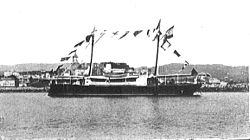
This list includes all naval ships which have been in service in the Spanish Navy and have been retired.
Contents
- Aircraft carriers
- Amphibious
- Armed launches
- Auxiliary ships
- Battleships
- Pre-dreadnought
- Dreadnought
- Carracks and Galleons
- Corvettes
- Cruisers
- Destroyers
- Frigates
- Gunboats
- Ironclads
- Broadside Ironclads
- Central Battery Ships
- Minelayer
- Mine countermeasures vessels
- Minor sailing vessels (incomplete)
- Monitor and floating battery
- Paddle steamers
- Patrol boats
- Sail frigates
- Screw frigates
- Screw corvettes
- Screw schooners
- Ships of the line
- Submarines
- Torpedo gunboat
- Torpedo boats
- Preserved ships
- See also
- References
- Notes
- Bibliography











































